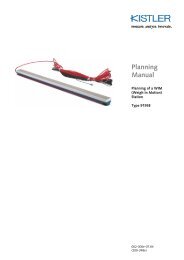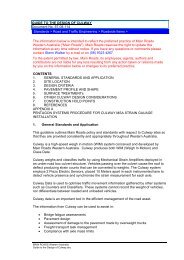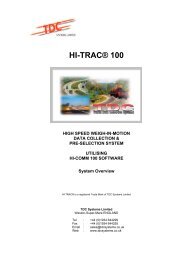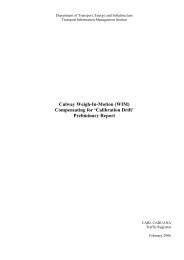AP-G84/04 Best practice in road use data collection, analysis ... - WIM
AP-G84/04 Best practice in road use data collection, analysis ... - WIM
AP-G84/04 Best practice in road use data collection, analysis ... - WIM
You also want an ePaper? Increase the reach of your titles
YUMPU automatically turns print PDFs into web optimized ePapers that Google loves.
Accessed by AR - ARRB TRANSPORT RESEARCH on <strong>04</strong> Feb 2005<br />
Aust<strong>road</strong>s 20<strong>04</strong><br />
— 23 —<br />
<strong>Best</strong> Practices <strong>in</strong> Road Use Data Collection, Analysis and Report<strong>in</strong>g<br />
4.3 Network Coverage<br />
Reports of AADT and VKT relate to the network where traffic is counted. As traffic counts are<br />
almost always a sample of the <strong>road</strong> network, the issue of network coverage or l<strong>in</strong>k-node<br />
development is important. The key issues are as follows:<br />
Difficulty <strong>in</strong> prescrib<strong>in</strong>g rules like number of permanent sites per km as each RA network is<br />
unique. Good judgement is required to def<strong>in</strong>e <strong>road</strong> sections or l<strong>in</strong>ks;<br />
Use of performance measures such as an <strong>in</strong>dication of the number of permanent sites for a<br />
given number of homogeneous sections;<br />
Frequency of review<strong>in</strong>g uniform traffic sections (UTS) or <strong>road</strong> sections; and<br />
Def<strong>in</strong>ition of homogeneous or uniform <strong>road</strong> sections.<br />
The accuracy of AADTs at sample stations depends critically on the selection of Pattern Stations,<br />
which alone provide the full year of traffic counts and from which the related short-term sites<br />
depend for their adjustment factors. In order to <strong>in</strong>crease the confidence <strong>in</strong> the pattern <strong>in</strong>formation<br />
ga<strong>in</strong>ed, the <strong>collection</strong> of <strong>data</strong> at all Short-term Stations <strong>in</strong> a pattern group should be made at the<br />
same time as the related Pattern Station (if it is seasonal) is be<strong>in</strong>g sampled.<br />
The accuracy of an AADT estimate depends partly on the reliability of group<strong>in</strong>g Short-term Stations<br />
with Pattern Stations, and the method of group<strong>in</strong>g is important. Areas with similar economy,<br />
culture and development tend to show similar traffic patterns, and proximity on its own may not be<br />
a good <strong>in</strong>dicator.<br />
This section deals with those issues and discusses good <strong>practice</strong>s found <strong>in</strong> each area. The<br />
follow<strong>in</strong>g sub-sections cover sampl<strong>in</strong>g (Section 4.3.1), frequency (Section 4.3.2), def<strong>in</strong><strong>in</strong>g<br />
homogeneous sections (Section 4.3.3) and directionality (Section 4.3.4).<br />
4.3.1 Sampl<strong>in</strong>g<br />
Sampl<strong>in</strong>g <strong>in</strong> a traffic count program relates to two separate yet <strong>in</strong>ter-related issues; the sampl<strong>in</strong>g<br />
unit and the frequency of sampl<strong>in</strong>g. Both issues are discussed <strong>in</strong> this section.<br />
Sampl<strong>in</strong>g Unit<br />
Pattern stations are best located by randomly select<strong>in</strong>g the number of sites on <strong>road</strong>s from each of<br />
a number of AADT strata, with<strong>in</strong> each geographical region. As a general rule, the density of<br />
stations <strong>in</strong> each stratum should be proportional to the product of the total length of <strong>road</strong> and the<br />
square root of the mean AADT <strong>in</strong> that stratum (Aust<strong>road</strong>s 20<strong>04</strong>).<br />
In <strong>practice</strong>, the number of Short-term Stations is determ<strong>in</strong>ed by the extent of the <strong>road</strong> system and<br />
the availability of funds. The number of Pattern Stations, and the ratio of Pattern Stations to Shortterm<br />
Stations, cannot be determ<strong>in</strong>ed <strong>in</strong> advance, beca<strong>use</strong> the assessment will depend on the<br />
regional group<strong>in</strong>g and the reliability of matched patterns. Thus, the achievement of consistent and<br />
specified accuracy levels <strong>in</strong> AADT estimation is essentially an iterative process that develops over<br />
time and with experience.<br />
The guidel<strong>in</strong>es for the densities of traffic count<strong>in</strong>g stations are shown <strong>in</strong> Table 10.

















